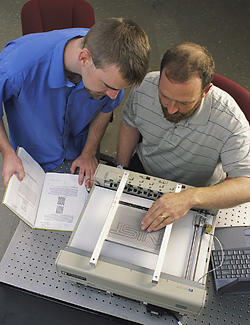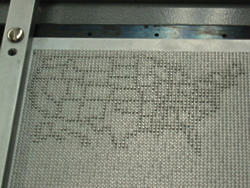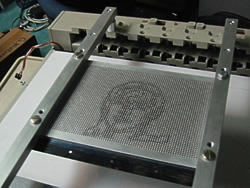
Researchers John Roberts (right) and Oliver Slattery (left) using the tactile graphic display device to depict the NIST logo.
Seeing is believing, unless you're blind or visually impaired. To this group, the National Institute of Standards and Technology (NIST) says, "try feeling is believing."
Computer scientists and engineers in NIST's Information Technology Laboratory (ITL) have created two tactile graphic displays that bring electronic images to the blind and visually impaired in the same way that Braille makes words readable.
The first graphic display technology, introduced as a prototype in 2002, conveys scanned illustrations, map outlines or other graphical images to the fingertips, and can translate images displayed on Internet Web pages or in electronic books. It uses refreshable tactile graphic display technology, allowing a person to feel a succession of images on a reusable surface.
The machine uses about 3,600 small pins—known as actuator points—that can be raised in any pattern, and then locked into place to hold the pattern for reading. The actuator points then can be withdrawn and reset in a new pattern, allowing the tactile reading to continue through a variety of images.
Each image is sent electronically to the device, which uses software to determine how to create a tactile display that matches the image.
An array of about 100 small, very closely spaced (1/10 of a millimeter apart) actuator points set against a user's fingertip is the key to the second tactile graphic display technology. To "view" a computer graphic with this technology, a blind or visually impaired person moves the device-tipped finger across a surface like a computer mouse to scan an image in computer memory.
The computer sends a signal to the display device and moves the actuators against the skin to "translate" the pattern, replicating the sensation of the finger moving over the pattern being displayed.
With further development, this technology could possibly be used to make fingertip tactile graphics practical for virtual reality systems or give a detailed sense of touch to robotic control (teleoperation) and space suit gloves.
NIST Prototype Tactile Visual Display showing:


The inspiration for both tactile graphic displays came from a "bed of nails" toy found in a novelty store. Watching the pins in the toy depress under fingers and then return to their original state started the ITL team thinking about how the principle could be applied to electronic signals.
NIST signed a non-exclusive license for commercialization of its two tactile graphic display technologies in the fall of 2007 with ELIA Life Technology Inc. of New York, N.Y. Others interested in licensing these technologies should contact Terry Lynch, NIST Office of Technology Partnerships, terry.lynch [at] nist.gov (terry[dot]lynch[at]nist[dot]gov), (301) 975-2691.

